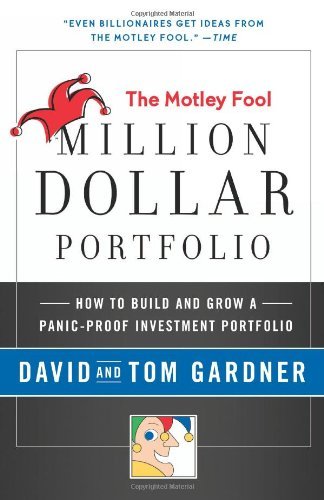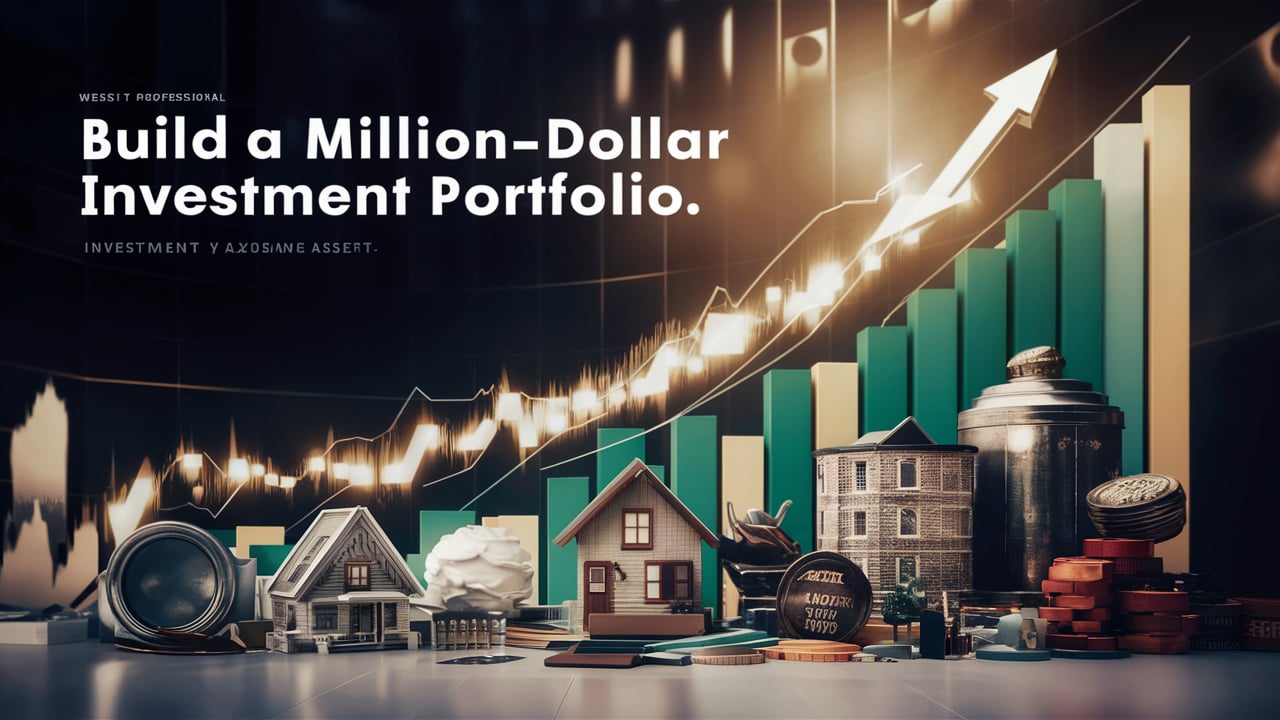To build a million-dollar investment portfolio, start with a clear financial plan and diversify your investments. Consistent contributions and smart choices are key.
Building a million-dollar investment portfolio is a goal many aspire to achieve. It requires strategic planning, disciplined saving, and informed decision-making. Begin by setting clear financial goals and understanding your risk tolerance. Diversification is crucial; spread your investments across various asset classes like stocks, bonds, and real estate.
Regularly contribute to your portfolio, taking advantage of compound interest over time. Stay informed about market trends and adjust your strategy as needed. Patience and consistency are vital. By following these steps, you can steadily grow your wealth and reach your million-dollar goal.
Setting Financial Goals
Building a million-dollar investment portfolio requires clear and achievable financial goals. This section will guide you through setting these goals, ensuring you stay on track and motivated.
Short-term Objectives
Short-term objectives are crucial for immediate progress. These goals should be specific, measurable, attainable, relevant, and time-bound (SMART).
- Emergency Fund: Aim to save 3-6 months of expenses.
- Debt Repayment: Focus on paying off high-interest debts first.
- Initial Investments: Start with small, consistent investments in diverse assets.
Use a table to track your short-term goals:
| Goal | Target Amount | Time Frame | Status |
|---|---|---|---|
| Emergency Fund | $10,000 | 12 months | In Progress |
| Debt Repayment | $5,000 | 6 months | Completed |
| Initial Investments | $2,000 | 3 months | In Progress |
Long-term Vision
Long-term vision shapes your future wealth. Think big and plan carefully.
- Retirement Planning: Estimate how much you need for a comfortable retirement.
- Real Estate Investments: Consider investing in properties for passive income.
- Education Funds: Plan for your children’s education expenses.
Break down your long-term goals into actionable steps:
- Maximize contributions to retirement accounts annually.
- Research and invest in rental properties.
- Start a 529 plan for education savings.
Review and adjust your goals regularly to stay aligned with your long-term vision.
Understanding Risk Tolerance
Building a million-dollar investment portfolio involves understanding your risk tolerance. Knowing how much risk you can handle is crucial. It helps guide your investment decisions.
Assessing Personal Comfort
Assessing your personal comfort with risk is the first step. Think about your financial goals. Are you saving for retirement, a house, or education?
Next, evaluate your current financial situation. Do you have debts or an emergency fund? Knowing your financial health helps you understand your risk capacity.
Finally, consider your emotional response to market changes. Can you handle seeing your investments fluctuate? If market volatility stresses you, you may prefer lower-risk investments.
| Factor | Questions to Ask |
|---|---|
| Financial Goals | What am I saving for? |
| Current Financial Situation | Do I have debts or an emergency fund? |
| Emotional Response | Can I handle market fluctuations? |
Balancing Risk And Reward
Balancing risk and reward is key to a successful portfolio. Higher-risk investments can offer greater rewards. But they also come with potential losses.
Low-risk investments are safer. They provide steady but smaller returns. Balancing both types can help you reach your financial goals.
Consider diversifying your portfolio. Diversification spreads your investments across different assets. This strategy can help manage risk and enhance returns.
- Stocks: High risk, high reward
- Bonds: Low risk, steady returns
- Real Estate: Moderate risk, potential for growth
Regularly review your portfolio. Adjust your investments based on your risk tolerance. This practice ensures your investments align with your financial goals.
Diversifying Investments
Building a million-dollar investment portfolio requires strategic planning and execution. One crucial strategy is diversifying investments. Diversification helps spread risk and maximize returns. This section covers key aspects of diversification.
Asset Classes
Diversifying across asset classes is essential. Different assets perform differently under various market conditions. Here are some major asset classes:
- Stocks: Offers high returns but comes with higher risk.
- Bonds: Provides stable returns and lower risk.
- Real Estate: Generates rental income and potential appreciation.
- Commodities: Includes gold, silver, and oil. Offers a hedge against inflation.
- Cash Equivalents: Includes savings accounts and money market funds. Offers liquidity and safety.
Allocating investments across these asset classes reduces risk. It also offers multiple streams of returns.
Geographic Spread
Investing in different geographic regions is another way to diversify. Different regions have different economic conditions and growth rates. Here are some strategies:
- Domestic Investments: Invest in your home country. Understand the local market better.
- International Investments: Invest in other countries. Gain exposure to global markets.
- Emerging Markets: High growth potential but comes with higher risk.
- Developed Markets: More stable but offers moderate growth.
A balanced geographic spread minimizes the impact of local downturns. It also captures global growth opportunities.
| Asset Class | Risk Level | Potential Return |
|---|---|---|
| Stocks | High | High |
| Bonds | Low | Moderate |
| Real Estate | Moderate | High |
| Commodities | Moderate | Varies |
| Cash Equivalents | Low | Low |
Using a mix of asset classes and geographic spread is key. This approach helps build a resilient and profitable investment portfolio.

Credit: www.harpercollins.com
Choosing The Right Investment Vehicles
Building a million-dollar investment portfolio requires strategic decisions. One of the most crucial steps is choosing the right investment vehicles. This decision involves selecting assets that align with your financial goals. Proper selection can significantly impact your portfolio’s growth and stability.
Stocks And Bonds
Stocks represent ownership in a company. They offer high potential returns. Investing in stocks can be risky. Companies can perform poorly, affecting your investment.
Bonds, on the other hand, are loans to companies or governments. They are generally safer than stocks. Bonds provide regular interest payments. They are less volatile, offering steady returns.
| Stocks | Bonds |
|---|---|
| High potential returns | Steady returns |
| Higher risk | Lower risk |
| Ownership in a company | Loan to an entity |
Mutual Funds And Etfs
Mutual funds pool money from many investors. A professional manager invests this money in various assets. Mutual funds offer diversification. They reduce risk by spreading investments.
ETFs, or Exchange-Traded Funds, are similar to mutual funds. They are traded on stock exchanges like individual stocks. ETFs offer flexibility. They can be bought and sold throughout the day.
- Mutual funds are actively managed.
- ETFs usually have lower fees.
- Both provide diversification.
- ETFs are more liquid than mutual funds.
Choosing between mutual funds and ETFs depends on your needs. Consider costs, management style, and liquidity.
Building A Strong Portfolio
Building a strong portfolio is key for achieving your financial goals. A balanced portfolio reduces risk and increases potential returns. We will explore two main components: core investments and satellite investments.
Core Investments
Core investments form the foundation of your portfolio. These are typically stable and low-risk assets. They provide steady growth over time. Examples include:
- Index Funds: These funds track a market index like the S&P 500.
- Blue-Chip Stocks: Shares of well-established companies with a history of reliable returns.
- Bonds: Debt securities that pay interest over a fixed period.
Core investments should make up the majority of your portfolio. They offer stability and help in weathering market volatility.
Satellite Investments
Satellite investments add growth potential to your portfolio. They are typically higher-risk but can offer higher returns. Examples include:
- Small-Cap Stocks: Shares of smaller companies with high growth potential.
- Emerging Markets: Investments in developing countries with expanding economies.
- Sector Funds: Funds focused on specific industries like technology or healthcare.
Satellite investments should complement your core investments. They add diversity and can boost overall returns.
Here’s a sample allocation table for a balanced portfolio:
| Investment Type | Percentage |
|---|---|
| Index Funds | 40% |
| Blue-Chip Stocks | 30% |
| Bonds | 20% |
| Small-Cap Stocks | 5% |
| Emerging Markets | 3% |
| Sector Funds | 2% |
This structure balances safety and growth. It aims to achieve long-term financial success.

Credit: www.amazon.com
Regular Portfolio Rebalancing
Regular portfolio rebalancing is crucial for building a million-dollar investment portfolio. It helps maintain your desired asset allocation. This practice ensures your investments align with your financial goals. Let’s explore two key aspects of portfolio rebalancing: monitoring performance and adjusting allocations.
Monitoring Performance
Consistently tracking your portfolio’s performance is vital. Use reliable tools and apps to monitor your investments. Keep an eye on each asset class’s growth or decline. This helps identify imbalances early. Regular performance checks protect your portfolio from unwanted risks.
- Check your portfolio at least once a quarter.
- Compare current allocations with your target allocations.
- Note any significant changes or trends.
Adjusting Allocations
Adjusting allocations keeps your portfolio balanced. When one asset class grows faster, it can dominate your portfolio. This can increase risk. Rebalancing involves selling overgrown assets and buying underrepresented ones. This keeps your portfolio aligned with your goals.
Follow these steps to adjust your allocations:
- Identify the overperforming and underperforming assets.
- Sell a portion of the overperforming assets.
- Buy more of the underperforming assets.
This table shows an example of rebalancing a portfolio:
| Asset Class | Initial Allocation | Current Allocation | Target Allocation | Action |
|---|---|---|---|---|
| Stocks | 50% | 60% | 50% | Sell 10% |
| Bonds | 30% | 25% | 30% | Buy 5% |
| Real Estate | 20% | 15% | 20% | Buy 5% |
Regular rebalancing ensures a balanced and diversified portfolio. It minimizes risks and maximizes returns. Follow these steps to build your million-dollar portfolio.
Minimizing Investment Costs
Building a million-dollar investment portfolio requires careful planning and strategy. One key aspect is minimizing investment costs. Lowering your expenses can significantly boost your returns over time. Here are some effective ways to reduce your investment costs.
Low-cost Funds
Investing in low-cost funds can save you a lot of money. These funds have lower fees, which means more of your money stays invested. Look for index funds or ETFs with low expense ratios. Here’s a comparison to help you:
| Fund Type | Average Expense Ratio |
|---|---|
| Index Funds | 0.05% – 0.20% |
| Active Funds | 0.60% – 1.50% |
Choosing low-cost funds can save you thousands in the long run.
Tax-efficient Strategies
Using tax-efficient strategies can also minimize your investment costs. These strategies help you keep more of your returns by reducing your tax liability.
- Tax-Deferred Accounts: Invest in IRAs or 401(k)s to defer taxes.
- Tax-Loss Harvesting: Sell losing investments to offset gains.
- Municipal Bonds: Earn tax-free interest income.
Implementing these strategies can make a significant difference in your portfolio’s growth.
Remember, every dollar saved on costs can be reinvested. This helps you reach your goal of a million-dollar portfolio faster.

Credit: www.bargainbookhutonline.com
Seeking Professional Advice
Building a million-dollar investment portfolio requires strategic planning and expert guidance. Seeking professional advice can provide the necessary insights and tools. This section explores two main avenues: Financial Advisors and Robo-Advisors.
Financial Advisors
Financial advisors offer personalized guidance tailored to your financial goals. They help you make informed decisions. Financial advisors analyze your current financial situation. They create a customized investment plan.
- Personalized Advice: Tailored strategies based on your unique needs.
- Expert Knowledge: Advisors have extensive market knowledge and experience.
- Ongoing Support: Regular reviews and adjustments to your investment plan.
Financial advisors charge fees for their services. These fees vary based on the level of service. Ensure you understand the fee structure before hiring an advisor.
Robo-advisors
Robo-advisors offer automated, algorithm-driven financial planning services. They are a cost-effective alternative to traditional advisors. Robo-advisors use advanced algorithms to manage your portfolio.
- Low Fees: Generally lower than traditional financial advisors.
- Accessibility: Available online 24/7, making them highly convenient.
- Automated Management: Constant portfolio monitoring and rebalancing.
Many robo-advisors offer customizable portfolios. These portfolios align with your risk tolerance and investment goals. They provide a user-friendly interface for easy management.
| Aspect | Financial Advisors | Robo-Advisors |
|---|---|---|
| Personalization | High | Moderate |
| Cost | Higher | Lower |
| Accessibility | Office Hours | 24/7 Online |
Choosing between financial advisors and robo-advisors depends on your specific needs. Consider both options to determine the best fit for your investment journey.
Frequently Asked Questions
How Long Does It Take To Build A Million-dollar Portfolio?
Building a million-dollar portfolio can take 10-30 years, depending on investment strategy, market conditions, and savings rate.
What Is The Safest Investment For $1 Million Dollars?
The safest investment for $1 million is U. S. Treasury bonds. They offer low risk and stable returns.
How Much Do I Need To Invest To Get To 1 Million?
To reach 1 million, investment depends on factors like starting amount, interest rate, and time. Use investment calculators for precise estimates.
How To Invest $100 000 To Make $1 Million?
Invest in diversified assets like stocks, real estate, or startups. Use dollar-cost averaging and reinvest profits. Seek expert advice. Avoid high-risk ventures.
Conclusion
Building a million-dollar investment portfolio requires strategy, discipline, and patience. Start with clear financial goals and consistent saving. Diversify your investments to manage risk. Keep educating yourself about market trends and financial strategies. Regularly review and adjust your portfolio. With dedication, your financial dreams can become reality.

Olga L. Weaver is a distinguished figure in both the realms of real estate and business, embodying a unique blend of expertise in these interconnected domains. With a comprehensive background in real estate development and a strategic understanding of business operations, Olga L. Weaver has positioned herself as a trusted advisor in the complex intersection of property and commerce. Her career is marked by successful ventures in real estate, coupled with a keen ability to integrate sound business principles into property investments. Whether navigating the intricacies of commercial transactions, optimizing property portfolios, or providing strategic insights into market trends, Olga L. Weaver’s expertise encompasses a wide spectrum of both real estate and business-related topics. As a dual expert in real estate and business, she stands as a guiding force, empowering individuals and organizations with the knowledge and strategies needed to thrive in these intertwined landscapes. Olga L. Weaver’s contributions continue to shape the dialogue around the synergy between real estate and business, making her a respected authority in both fields.


